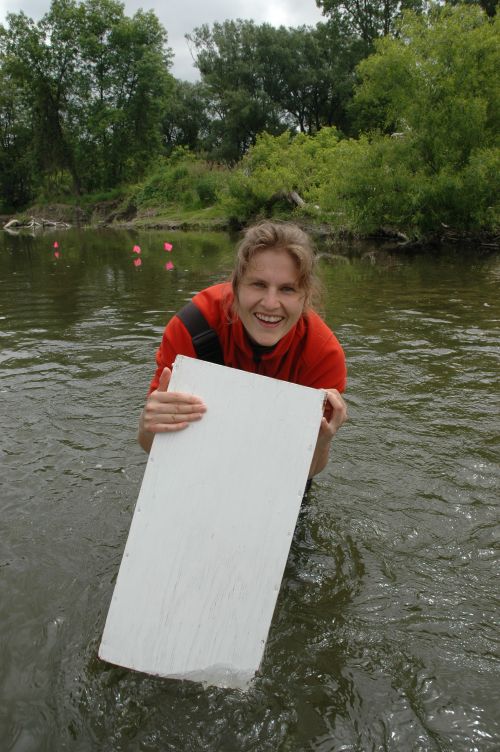
Home
Curriculum vitae
Projects &
workshops
Publications
Ph.D. thesis
Contact
Susann Wilhelms Website
Ph.D. thesis
Climate induced impacts on lake functioning in summer
This thesis is electronically published on the publications server at Potsdam University, Germany. This work was carried out at the Leibniz-Institute of Freshwater Ecology and Inland Fisheries (IGB) in Berlin within the EU-Project "Climate and Lake Impacts in Europe" (CLIME).Summary
There is already strong evidence that temperate lakes have been highly vulnerable to human induced climate warming during the last century. Hitherto climate impact studies have mainly focussed on the impacts of the recent long-term warming in winter and spring and little is known on the influence of climate warming on temperate lakes in summer. In the present thesis, I studied some aspects, which may have been strongly involved in determining the response of a lake to climate warming in summer. Thereby I have focussed on climate induced impacts on the thermal characteristics and the phenology and abundance of summer plankton in a shallow polymictic lake (Müggelsee, Germany).First, the influence of climate warming on the phenology and abundance of the lake plankton was investigated across seasons. Fast-growing spring phytoplankton and zooplankton (Daphnia) advanced largely synchronously, whereas long-term changes in the phenology of slow-growing summer zooplankton were clearly species-specific and not synchronised. The phenology and/or abundance of several summer copepod species changed according to their individual thermal requirements at decisive developmental stages such as emergence from diapause in spring. The study emphasises that not only the degree of warming, but also its timing within the annual cycle is of great ecological importance.
To analyse the impact of climate change on the thermal characteristics of the lake, I examined the long-term development of the daily epilimnetic temperature extrema during summer. The study demonstrated for the first time for lakes that the daily epilimnetic minima (during nighttime) have increased more rapidly than the daily epilimnetic maxima (during daytime), resulting in a distinct decrease in the daily epilimnetic temperature range. This day-night asymmetry in epilimnetic temperature was likely caused by an increased nighttime emission of long-wave radiation from the atmosphere. This underlines that not only increases in air temperature, but also changes in other meteorological variables such as wind speed, relative humidity and cloud cover may play an important role in determining the lake temperature with respect to further climate change.
Furthermore, a short-term analysis on the mixing regime of the polymictic lake was conducted to examine the frequency and duration of stratification events and their impacts on dissolved oxygen, dissolved nutrients and summer phytoplankton. Even during the longest stratification events (heatwaves in 2003 and 2006) the thermal characteristics of the lake differed from those typically found in shallow dimictic lakes, which exhibit a continuous stratification during summer. Particularly, hypolimnetic temperatures were higher, favouring the depletion of oxygen and the accumulation of dissolved nutrient in the hypolimnion. Thermal stratification will be very likely amplified in the future, thus, I conclude that polymictic lakes will be very vulnerable to alterations in the thermal regime with respect to projections of further climate change during summer.
Finally, a long-term case study on the long and short-term changes in the development of the planktonic larvae of the freshwater mussel Dreissena polymorpha was performed to analyse the impacts of simultaneous changes in the thermal and in the trophic regime of the lake. Both the climate warming and the decrease in external nutrient load were important in determining the abundance of the pelagic larvae by affecting different features of the life-history of this species throughout the warm season. The long-term increase in the abundance and length of larvae was related to the decrease in external nutrient loading and the change in phytoplankton composition. However, the recent heatwaves in 2003 and 2006 have offset this positive effect on larval abundance, due to unfavourable low oxygen concentrations that had resulted from extremely long stratification events, mimicking the effects of nutrient enrichment. Climate warming may thus induce counteracting effects in productive shallow lakes that underwent lake restoration through a decrease in external nutrient loading.
I conclude that not only the nature of climate change and thus the timing of climate warming throughout the seasons and the occurrence of climatic extremes as heatwaves, but also site-specific lake conditions as the thermal mixing regime and the trophic state are crucial factors governing the impacts of climate warming on internal lake processes during summer. Consequently, further climate impact research on lake functioning should focus on how the different lake types respond to the complex environmental forcing in summer, to allow for a comprehensive understanding of human induced environmental changes in lakes.